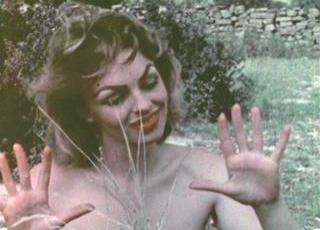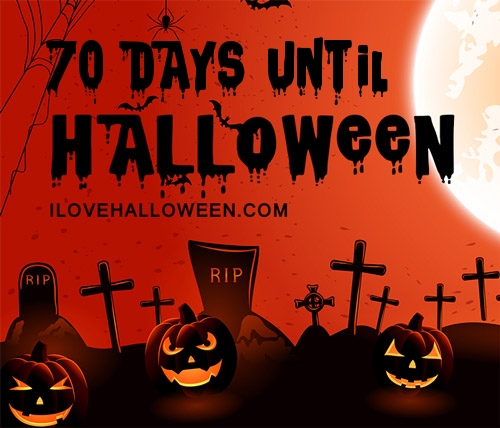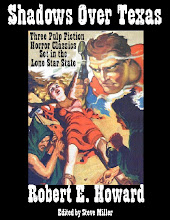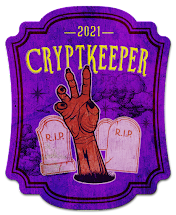A favorite actress of mine from the 1930s is June Collyer. Below, I present reviews of a trio of her pictures that make for a great in-home film festival. Have some friends over for an evening of old-time chillers and light-hearted mystery, and discover the radiance of
NUELOW Games's unofficial mascot!
Have some fellow movie buffs over for a light dinner, make some popcorn, and then settle in for a fun night of classic movies. All three films can be had on DVD for extremely reasonable prices--and they may even be available for free streaming online if your television is hooked up to the internet. (Me, I still prefer DVDs... there's no risk of load-time lag with them.)
If you and your friends are gamers, perhaps you can even fit in a little roleplaying fun in between or after the films. As mentioned, June Collyer is the unofficial mascot of NUELOW Games, so it stands to reason she'd be featured in one of their products--a product titled "Black Kitten vs. June Collyer" written by yours truly as a supplement for
ROLF!: The Rollplaying Game. It's got superheroes, movie stars, and communist zombies... all ready for you to play, or for you to fight with characters of your own creation. (
Click here for more information about, and to see previews of, "Black Kitten vs. June Collyer".)
The Drums of Jeopardy (1931)
Starring: Warner Oland, June Collyer, Lloyd Hughes, Hale Hamilton, Wallace MacDonald, Clara Blandick, and Mischa Auer
Director: George B. Seitz
Rating: Seven of Ten Stars
When one of the men of the Petrov family makes his daugher pregnant, dumps her, and causes her to commit suicide, but then won't own up to his misdeed, Dr. Boris Karlov (Oland) sets out to gain revenge by seeing them all dead. He persues them halfway around the world, to America, where a secret service agent (Hamilton) and a feisty young American woman (Collyer) end up in the middle of this Russian struggle for survival and revenge.

"The Drums of Jeopardy" is a nifty little thriller from the early days of talkies that's jam-packed with drama, action, and humor. Its fast-paced script hardly gives the viewers a chance to realize that just about everything in this film has become almost painfully cliche in the nearly eighty years since its original release, nor does it pause long enough to really let us consider how outrageous and dimwitted the "brilliant" plan of the Federal Agents who match wits with Karlov is. We're too busy hating the slimy Russian nobleman Prince Gregor (Wallace MacDonald) who not only impregnated and dumped a poor girl, but who then refuses to live up to what he's done and ultimately tries to sell out everyone else to save his own skin; admiring the beauty of the resourceful young Kitty Connover (June Collyer, as great as she's ever been); snickering at the comic relief provided by her sharp-tongued aunt (Clara Blandick), and grinning with sinister glee as Dr. Karlov delivers zingers and pulls tricks on the good guys that allows him to take a place among the great villains of movie history 's zingers as his evil plans fall into place (an honor deserved in no small part due to an excellent performance by character actor Warner Oland who is best remembered for playing Charlie Chan).
Another remarkable aspect of this film that sets it apart from many others from this period is that it has a villain that the viewer can relate to. His daughter was violated and tossed aside by the Petrovs, so, given that this is a melodramatic thriller and we're talking about Russians here, it's only natural he'd take elaborate and final revenge against not only the Petrovs but Russian nobility in general. Karlov is a character who is almost like a tragic hero in his stature within this film and he is must more interesting than most film villains from the early days of film.
I should note that as much as I enjoyed this film, I was a little disappointed in some aspects of how the story unfolded. I've already commented on the moronic nature of the government agents in the film, but a bigger dissapointment was that Karlov didn't really get his full revenge and we don't get to see that rat bastard Gregor die a slow and painful death. (That alone makes me wish for a remake of this movie. I'd love to see Tim Thomerson as Karlov!)
Speaking of Karlov... yes, the villain of this movie is named Boris Karlov. Given that this film is based on an American novel that was originally published in 1920, I think we can chalk this up to one of those weird coincidences. Karloff was an obscure stage actor touring Canadian backwaters at the time the book was written. (Although at least one source claims that Karloff chose his screen name because of the novel.)
All in all, "The Drums of Jeopardy" is a great little film that really deserves better than to be trampled to dust under the marching feet of pop culture and swept away by the passage of time.
The Ghost Walks (1934)
Starring: John Miljan, Richard Carle, Johnny Arthur, Spencer Charters, June Collyer, Donald Kirke and Eve Southern
Director: Frank R. Strayer
Rating: Seven of Ten Stars
A playwright (Miljan) invites a theatrical producer (Carle) and his fey secretary (Arthur) to join him in the country so they can discuss his latest play. The writer has secretly hired a bunch of actors who will perform the play, essentially hoaxing the producer with a fake murder, hoping he'll be amazed by the play's realism. His plan backfires, however, when one of the actors turns up dead for real and they receive word that a dangerous lunatic has escaped from a nearby asylum.

"The Ghost Walks" is a highly entertaining comic mystery that takes the mainstays of the "dark old house" genre that flourished in the early 1930s and mixes it with an Agatha Christie vibe and throws in a "mad doctor" (or maybe just the legend of one?) for good measure. Oh, and these elements are mixed up by several plot twists that will surprise and amuse even the most experienced viewer of films from this period.
This is a fine little movie that doesn't deserve the obscurity it has been relegated to. It features a well-paced script filled with great plot twists, snappy dialogue and a brand of comedy that has held up nicely to the passage of time. While the film has plenty of elements that are standard (it's a dark and stormy night, the characters are all trapped in the house with a killer and people keep dying and/or vanishing mysteriously no matter what the survivors try) it's comic relief characters and the overall thrust of the gags are highly unusual for a film from this period. (Basically, instead of the dippy, superstitious black manservant, we have a effeminate secretary to a pompous theatrical agent, both of whom aren't half as smart as they think they are... but the audience has a great time laughing at their expense. And, with the exception of the psychotically PC who can't laugh at anything except rednecks or Christians being lampooned, these comic relief characters and the jokes around them are ones that can be enjoyed today without that uncomfortable feeling of racism.)
The print of "The Ghost Walks" that I watched was very worn and damaged in many places. All the frames were there, but there was lots of scratches on the film and the image was often very blurry. I suspect that digital video and the DVD format came along just in time to rescue this film from oblivion. Director Frank Strayer was definately one of the most talented people working in independent, low-budget films during the 1930s; I've enjoyed every one of his films, with "The Monster Walks" being the only one I haven't given a Fresh rating to.
"The Ghost Walks" is worth checking out if you enjoy lighthearted mysteries, even if you aren't a big fan of early cinema.
A Face in the Fog (1936)
Starring: Lloyd Hughes, June Collyer, Al St. John, and Lawrence Gray
Director: Robert Hill
Rating: Five of Ten Stars
When society reporter-trying-to-become-a-crimebeat-reporter Jean Monroe (Collyer) claims to have seen the face of the mysterious killer who is poisoning theatre people in the city, and that she intends to reveal his identity in a future column, she becomes his next target. Her fiance and fellow reporter Frank Gordon (Hughes) teams with criminologist and playwright Peter Fortune (Gray) to catch the killer before he claims Jean's life.

"A Face in the Fog" is one of those weakly written mysteries where there is only one possible suspect, who, after concocting a really brilliant method of committing his murders, subsequently behaves so stupidly that even Barney Fife could have caught him while in the middle of a three-day moonshine bender. The plot also doesn't make a lot of sense, nor do the reasons for who the killer chooses as his victims.
However, the actors perform with such charm and sincerity, and the film moves at such a break-neck pace that you'll hardly have time to notice its shortcomings--which means my criticisms probably amount to no more than nitpicking. June Collyer as the stubbornly brave, career-minded journalist is especially good, in what proved to be her last movie before she left acting for some 15 years to raise her children.
Although this is an entertaining enough movie, with an excellent cast and sharp direction, the script is just shaky enough that I can't give it a wholehearted recommendation. Admirers of June Collyer or Lloyd Hughes should certainly check it out, and I think it's worth adding to the line-up of any in-home film festival you might want to hold centering on either one, but it's not quite a must-see if you're just looking for something to pass the time with.




























